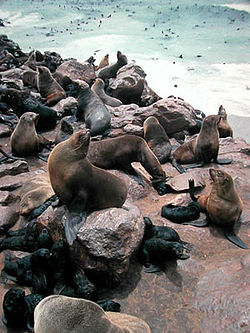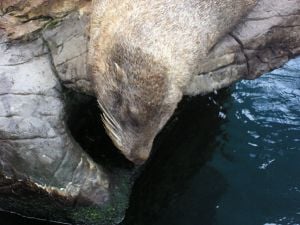Difference between revisions of "Fur seal" - New World Encyclopedia
Rick Swarts (talk | contribs) (added article from Wikipedia and credit/category tag) |
Rick Swarts (talk | contribs) |
||
| Line 16: | Line 16: | ||
''[[Callorhinus]]''<br /> | ''[[Callorhinus]]''<br /> | ||
''[[Arctocephalus]]''}} | ''[[Arctocephalus]]''}} | ||
| − | '''Fur | + | '''Fur seal''' is the common name for any of the marine mammals in the [[pinniped]] [[genus|genera]] ''Callorhinus'' (1 extant species) and ''Arctocephalus'' (seven extant species), characterized by underfur covered with long guard hairs. |
| − | == | + | |
| + | |||
| + | are any of nine species of [[pinnipeds]] in the ''[[Otariidae]]'' family. One species, the [[northern fur seal]] (''Callorhinus ursinus'') inhabits the North Pacific, while seven species in the ''[[Arctocephalus]]'' genus are found primarily in the Southern hemisphere. They are much more closely related to [[sea lions]] than [[true seals]], and share with them external ears ([[pinnae]]), relatively long and muscular foreflippers, and the ability to walk on all fours. They are marked by their dense [[pelage|underfur]], which made them a long-time object of commercial [[sealing|hunting]]. | ||
| + | |||
| + | is not a formal [[taxonomy|taxonomic]] rank, | ||
| + | |||
| + | ==Overview== | ||
Until recently, fur seals were all grouped under a single subfamily of Pinnipedia called ''Arctocephalinae'' to contrast them with ''Otariinae'' - the sea lions - based on the most prominent common feature, namely the coat of dense underfur intermixed with guard hairs. Recent genetic evidence, however, suggests that ''Callorhinus'' is more closely related to some sea lion species, and the fur seal/sealion subfamily distinction has been eliminated from most taxonomies. Nonetheless, all fur seals have certain features in common: the fur, generally smaller sizes, farther and longer foraging trips, smaller and more abundant prey items and greater [[sexual dimorphism]]. For these reasons, the distinction remains useful. | Until recently, fur seals were all grouped under a single subfamily of Pinnipedia called ''Arctocephalinae'' to contrast them with ''Otariinae'' - the sea lions - based on the most prominent common feature, namely the coat of dense underfur intermixed with guard hairs. Recent genetic evidence, however, suggests that ''Callorhinus'' is more closely related to some sea lion species, and the fur seal/sealion subfamily distinction has been eliminated from most taxonomies. Nonetheless, all fur seals have certain features in common: the fur, generally smaller sizes, farther and longer foraging trips, smaller and more abundant prey items and greater [[sexual dimorphism]]. For these reasons, the distinction remains useful. | ||
| + | |||
| + | more pointed snout and longer fore-flippers than sea lions, and they have a thick, luxuriant coat of fur (pelage) (Riedman 1990). The underfur, which is waterproof, is covered with long, "guard" hairs that give them a "somewhat grizzled appearance" (Riedman 1990). T | ||
==Physical appearance== | ==Physical appearance== | ||
Revision as of 01:06, 4 July 2008
Template:Common name for
| Fur seals | ||||||||||||
|---|---|---|---|---|---|---|---|---|---|---|---|---|
 Cape Fur Seal
| ||||||||||||
| Scientific classification | ||||||||||||
| ||||||||||||
|
Callorhinus |
Fur seal is the common name for any of the marine mammals in the pinniped genera Callorhinus (1 extant species) and Arctocephalus (seven extant species), characterized by underfur covered with long guard hairs.
are any of nine species of pinnipeds in the Otariidae family. One species, the northern fur seal (Callorhinus ursinus) inhabits the North Pacific, while seven species in the Arctocephalus genus are found primarily in the Southern hemisphere. They are much more closely related to sea lions than true seals, and share with them external ears (pinnae), relatively long and muscular foreflippers, and the ability to walk on all fours. They are marked by their dense underfur, which made them a long-time object of commercial hunting.
is not a formal taxonomic rank,
Overview
Until recently, fur seals were all grouped under a single subfamily of Pinnipedia called Arctocephalinae to contrast them with Otariinae - the sea lions - based on the most prominent common feature, namely the coat of dense underfur intermixed with guard hairs. Recent genetic evidence, however, suggests that Callorhinus is more closely related to some sea lion species, and the fur seal/sealion subfamily distinction has been eliminated from most taxonomies. Nonetheless, all fur seals have certain features in common: the fur, generally smaller sizes, farther and longer foraging trips, smaller and more abundant prey items and greater sexual dimorphism. For these reasons, the distinction remains useful.
more pointed snout and longer fore-flippers than sea lions, and they have a thick, luxuriant coat of fur (pelage) (Riedman 1990). The underfur, which is waterproof, is covered with long, "guard" hairs that give them a "somewhat grizzled appearance" (Riedman 1990). T
Physical appearance
Fur seals share with other otariids the ability to turn their rear limbs forward and move on all fours. Fur seals are generally smaller than sea lions - at under 1 m, the Galapagos fur seal is the smallest of all pinnipeds. However, their flippers tend to be proportionately longer, their pelage tends to be darker and the vibrissae more prominent. Males are often more than five times heavier than the females, making them among the most sexually dimorphic of all mammal groups.
Behavior and ecology
Typically, fur seals gather during the summer months annually in large assemblages at specific beaches or rocky outcrops to give birth and breed. All species are polygynous, meaning dominant males reproduce with more than one female. For most species, total gestation lasts about 11.5 months, including a several month period of delayed implantation of the embryo. While northern fur seal males aggressively select and defend the specific females in their harems,[1] males of southern species of fur seal tend to protect spatial territories and females are free to choose or switch their mates according to their own preference or social hierarchy. After several continuous days of nursing the newborn pups, females go on extended foraging trips that can last as long as a week, returning to the rookery to feed their pups until they are weaned. Males fast during the reproductive season, unwilling to leave their females or territories.
The remainder of the year, fur seals lead a largely pelagic existence in the open sea pursuing their prey wherever it is abundant and plentiful. Fur seals feed on moderately sized fish, squid and krill. They are preyed upon by sharks, orcas, and occasionally by larger sea lions.
When fur seals were hunted in the late eighteenth and early nineteenth centuries, they hauled out on remote islands where there were no predators. The hunters reported being able to club they unwary animals to death one after another, making the hunt profitable even though the price per seal skin was low. [2]
Exploitation
Many fur seal species were heavily exploited by commercial sealers, especially during the 19th century when their fur was highly valued. Beginning in the 1790s, the ports of Stonington and New Haven, Connecticut were leaders of the American fur seal trade, which primarily entailed clubbing fur seals to death on uninhabited South Pacific islands, skinning them, and selling the hides in China.[3] Many populations, notably the Guadalupe fur seal, northern fur seal and Cape fur seal, suffered dramatic declines and are still recovering. Currently, most species are protected and hunting is mostly limited to subsistence harvest. Globally, most populations can be considered healthy, mostly due to the fact that they often prefer remote habitats that are relatively inaccessible to humans. Nonetheless, environmental degradation, competition with fisheries and climate change potentially pose threats to some populations.
Species
- SUBORDER PINNIPEDIA
- Family Otariidae
- Genus Arctocephalus
- Antarctic Fur Seal, A. gazella
- Guadalupe Fur Seal, A. townsendi
- Juan Fernandez Fur Seal, A. philippii
- Galapagos Fur Seal, A. galapagoensis
- Cape Fur Seal, A. pusillus
- South African Fur Seal, A. pusillus pusillus
- Australian Fur Seal, A. pusillus doriferus
- New Zealand Fur Seal or Southern Fur Seal, A. forsteri
- Subantarctic Fur Seal, A. tropicalis
- South American Fur Seal, A. australis
- Genus Callorhinus
- Northern Fur Seal, C. ursinus
- Genus Eumetopias
- Genus Neophoca
- Genus Otaria
- Genus Phocarctos
- Genus Zalophus
- Genus Arctocephalus
- Family Phocidae: true seals
- Family Odobenidae: Walrus
See also
- Seal (disambiguation)
- ↑ http://www.afsc.noaa.gov/NMML/education/Pinnipeds/furseals.htm
- ↑ Muir, Diana Reflections in Bullough's Pond, University Press of New England, 2001
- ↑ Muir, Diana, "Reflections in Bullough's Pond," University Press of New England, 2000,pp. 80ff.
| ||||||||||||||
Credits
New World Encyclopedia writers and editors rewrote and completed the Wikipedia article in accordance with New World Encyclopedia standards. This article abides by terms of the Creative Commons CC-by-sa 3.0 License (CC-by-sa), which may be used and disseminated with proper attribution. Credit is due under the terms of this license that can reference both the New World Encyclopedia contributors and the selfless volunteer contributors of the Wikimedia Foundation. To cite this article click here for a list of acceptable citing formats.The history of earlier contributions by wikipedians is accessible to researchers here:
The history of this article since it was imported to New World Encyclopedia:
Note: Some restrictions may apply to use of individual images which are separately licensed.
